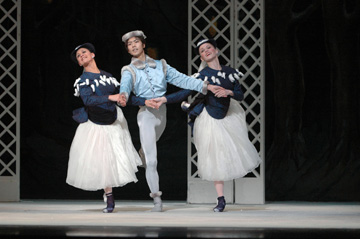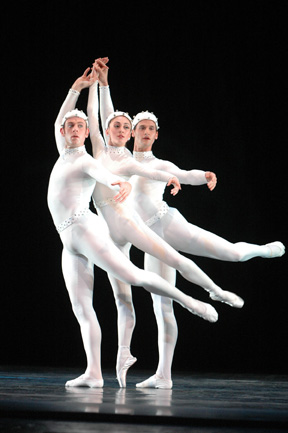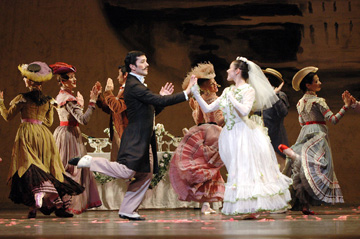Lincoln
Center Festival
Ashton Celebration
Another Chair
"Les Patineurs," "Monotones," and "A Wedding
Bouquet"
Joffrey Ballet of Chicago
Metropolitan Opera House
New York, NY, USA
Thursday, July 8, 2004
by George Jackson
copyright
© 2004 by George Jackson
published July 11, 2004
 Chicago,
once the hog butcher of the world, is also a place where the arts have
thrived. The Joffrey Ballet's banishment there has not been into solitary
confinement. Poetry Magazine, the Second City theater scene, Robert Maynard
Hutchins and Mortimer Adler's great books based university, buildings
by Sullivan, Root, Wright and Bauhaus refugees—these are a few examples
of Chicago work that is admired everywhere. The Joffrey's reappearance
in New York after a decade's absence showed a company that is recognizable.
Youthful and functionally trained, the Joffrey is still eager to please.
It suits its Ashton repertory better than before, inhabiting it with an
ease that allowed for subtlety.
Chicago,
once the hog butcher of the world, is also a place where the arts have
thrived. The Joffrey Ballet's banishment there has not been into solitary
confinement. Poetry Magazine, the Second City theater scene, Robert Maynard
Hutchins and Mortimer Adler's great books based university, buildings
by Sullivan, Root, Wright and Bauhaus refugees—these are a few examples
of Chicago work that is admired everywhere. The Joffrey's reappearance
in New York after a decade's absence showed a company that is recognizable.
Youthful and functionally trained, the Joffrey is still eager to please.
It suits its Ashton repertory better than before, inhabiting it with an
ease that allowed for subtlety.
"Les Patineurs" was buoyant, and its star was the corps. The
group of 8 "ice skaters" seemed to have gone to school together,
yet individuals peeked out from among the dancers as from a class photograph.
Not at all superimposed was the romantic couple, Suzanne Lopez and Michael
Levine. Rather, they emerged into prominence. At first, Levine looked
bulky on top in his white costume, yet his dancing and partnering were
as smooth as freshly sharpened blades on an evenly frozen pond. The two
pairs of girls— Deanne Brown and Julianne Kepley, and April Daly
and Erica Lynette Edwards—weren't just replicates of each other.
Each had her own maidenly traits, and Brown was an exceptional turner.
The one alien element was Masayoshi Onuki, in the bravura role of the
solo skater. True, this character is something of a loner, but Onuki's
fine boned build and calculated attack made him seem like someone visiting
from a far away military school. Even so, the Joffrey's "Patineurs"
ushered in the evening delightfully.
 When
the "Monotones" ballets, I and II, were first shown in New York
not long after their 1967 and 1966 premiers in London, they restored my
admiration for Frederick Ashton as a choreographer. I had been an Ashton
defender when, in 1949, American critics had received his ballets respectfully
but not enthusiastically on the then* Sadler's Wells Ballet's first visit
to North America. To American eyes of the time, Ashton fell between two
favorite stools—that of Antony Tudor's ballets of psychological
motivation and George Balanchine's musically projected choreography. The
first piece of dance writing I did for eyes other than my own was a letter
defending Ashton against Francis Mason's not-up-to-Balanchine estimate
that appeared in one of that era's important literary quarterlies. I argued
that Ashton deserved a stool of his own, and that at least two of the
legs it stood on were lyricism and finesse. (Mason sent me a very wise
reply.)
When
the "Monotones" ballets, I and II, were first shown in New York
not long after their 1967 and 1966 premiers in London, they restored my
admiration for Frederick Ashton as a choreographer. I had been an Ashton
defender when, in 1949, American critics had received his ballets respectfully
but not enthusiastically on the then* Sadler's Wells Ballet's first visit
to North America. To American eyes of the time, Ashton fell between two
favorite stools—that of Antony Tudor's ballets of psychological
motivation and George Balanchine's musically projected choreography. The
first piece of dance writing I did for eyes other than my own was a letter
defending Ashton against Francis Mason's not-up-to-Balanchine estimate
that appeared in one of that era's important literary quarterlies. I argued
that Ashton deserved a stool of his own, and that at least two of the
legs it stood on were lyricism and finesse. (Mason sent me a very wise
reply.)
After a season or two of Sadler's Wells visits, my enthusiasm for Ashton
waned. His antiquarian ballets ("Sylvia" of 1952, "Ondine"
of 1958, "La Fille mal gardee" of 1960, "Les deux pigeons"
of 1961) showed skill and had moments, yet lacked the miracle of something
new. In these works, Ashton undoubtedly developed his concepts of linearity
and lyricism, yet was doing so in the closet. Other blemishes began to
show—the twee quality sometimes and his inability to reach a choreographic
climax. The late critic Hope Sheridan called Ashton a choreographer of
Platonic love. With "Monotones", Ashton reclaimed his position
as a bold inventor.
 Less is more when speaking of the two "Monotones" trios to Erik
Satie music. They are about line—anatomic, musical, temporal, dynamic.
They are about possibility and law, about perpetual motion and absolute
rest. The later "Monotones", the one from 1967 which is danced
first, is cast in jade—the light green in the coloring of its costumes
for two women and a man. It has, perhaps, a hint of Oriental angularity.
On Thursday, I felt that the dancers—Jennifer Goodman, Calvin Kitten
and Stacy Joy Keller—should have repeated their performance and
then would have gotten it right. What we actually saw had no glaring faults.
It didn't, though, start from a point of absolute control and then glide.
This woman-man-woman entity reasserted control throughout the piece and
that seemed against the grain, no matter how hidden the effort.
Less is more when speaking of the two "Monotones" trios to Erik
Satie music. They are about line—anatomic, musical, temporal, dynamic.
They are about possibility and law, about perpetual motion and absolute
rest. The later "Monotones", the one from 1967 which is danced
first, is cast in jade—the light green in the coloring of its costumes
for two women and a man. It has, perhaps, a hint of Oriental angularity.
On Thursday, I felt that the dancers—Jennifer Goodman, Calvin Kitten
and Stacy Joy Keller—should have repeated their performance and
then would have gotten it right. What we actually saw had no glaring faults.
It didn't, though, start from a point of absolute control and then glide.
This woman-man-woman entity reasserted control throughout the piece and
that seemed against the grain, no matter how hidden the effort.
In the second "Monotones" trio, the one a season older, the
lighting is lunar and the symmetry Olympian, with lines defining angle
rather than angle determining lines. Michael Levine, Valerie Robin and
Samuel Pergande were not flawless. Robin slipped at one point, yet it
didn't matter because the dancers were in command of the situation. There
was no visible effort to reassert control. After the accident, the piece
continued as before. Nor was it bothersome that Pergande was taller than
Levine, because they were well matched and wonderful partners for the
remarkable Robin.
 The wit and wisdom of "A Wedding Bouquet" and the full joy of
the Joffrey's return to New York were spoiled by lousy acoustics. At the
Metropolitan Opera, of all places, one could hardly understand Christian
Holder's declamation of this ballet's Gertrude Stein text. Lord Berners's
music, sounding great as Leslie B. Dunner conducted it from the pit, helped
drown out the words. Holder's soft Caribbean enunciation didn't help either.
Mostly, though, it seemed the fault of the amplification system that those
delicious lines were muddied. Nevertheless, the non-speaking cast did
very well—Julianne Kepley as Webster, the wedding party's keeper
of law and order, and all the members of the wedding who perpetrate little
sins against propriety, particularly Deborah Dawn's tipsy Josephine, Maia
Wilkins's forlorn Julia, Willy Shives' slightly sleazy Bridegroom, Emily
Patterson's confident Bride and Heather Aagard's not too cute dog. Seeing
"Wedding Bouquet" from two locations during the week, I was
impressed how well the dancers projected to the Met's rafters without
exaggerating for those sitting close. There's a mistake in the printed
program, which referred to the ballet taking place at the beginning of
the 19th Century. Ashton's action, Stein's text and Lord Berners's sets
and costumes clearly place the ballet in the early 20th Century. Wisely,
the Joffrey has not substantially redesigned any of its Ashton ballets,
also using William Chapell's sets and costumes for "Patineurs"
and the streamlined, outside-time costumes for "Monotones".
The wit and wisdom of "A Wedding Bouquet" and the full joy of
the Joffrey's return to New York were spoiled by lousy acoustics. At the
Metropolitan Opera, of all places, one could hardly understand Christian
Holder's declamation of this ballet's Gertrude Stein text. Lord Berners's
music, sounding great as Leslie B. Dunner conducted it from the pit, helped
drown out the words. Holder's soft Caribbean enunciation didn't help either.
Mostly, though, it seemed the fault of the amplification system that those
delicious lines were muddied. Nevertheless, the non-speaking cast did
very well—Julianne Kepley as Webster, the wedding party's keeper
of law and order, and all the members of the wedding who perpetrate little
sins against propriety, particularly Deborah Dawn's tipsy Josephine, Maia
Wilkins's forlorn Julia, Willy Shives' slightly sleazy Bridegroom, Emily
Patterson's confident Bride and Heather Aagard's not too cute dog. Seeing
"Wedding Bouquet" from two locations during the week, I was
impressed how well the dancers projected to the Met's rafters without
exaggerating for those sitting close. There's a mistake in the printed
program, which referred to the ballet taking place at the beginning of
the 19th Century. Ashton's action, Stein's text and Lord Berners's sets
and costumes clearly place the ballet in the early 20th Century. Wisely,
the Joffrey has not substantially redesigned any of its Ashton ballets,
also using William Chapell's sets and costumes for "Patineurs"
and the streamlined, outside-time costumes for "Monotones".
During the very worthwhile first week of the Ashton fortnight at Lincoln
Center, "Enigma Variations" (performed by Birmingham Royal Ballet)
was the highpoint for me. The bill with three companies—Joffrey
of Chicago, Birmingham Royal and K-Ballet of Tokyo—and four ballets—"Rhapsody",
"Five Brahms Waltzes in the Manner of Isadora Duncan", "Dante
Sonata" and "A Wedding Bouquet"—cumulatively had
a distinct middle-of-the-20th Century aura about it. Some people may consider
that undesirable, but I don't when the ballets are from that period. What
generates the aura may not be choreography and drama as much as spacing,
lighting, scenery, costumes and make-up, although Ashton also wasn't known
to re-choreograph his completed works as much as Fokine or Balanchine.
Curiously, the revised production of "Rhapsody" made it seem
to be an earlier work than it actually is.
* then Sadler's Wells Ballet is now Britain's Royal Ballet of Covent Garden
Photos, all
performance shots by Stephanie Berger:
First: Deanne Brown, Masayoshi Onuki, and Julianne Kelly of the Joffrey
Ballet in "Les Patineurs."
Second: Jennifer Goodman, Calvin Kitten, Stacy Joy Keller in "Monotones
I."
Third: Michael Levine. Victoria Jaiani. Samuel Pergande in "Monotones
II."
Fourth: "A Wedding Bouquet."
Originally
published:
July 11, 2004
www.danceviewtimes.com
Volume 2, Ashton Section
Copyright
©2004 by George Jackson
|
|
|